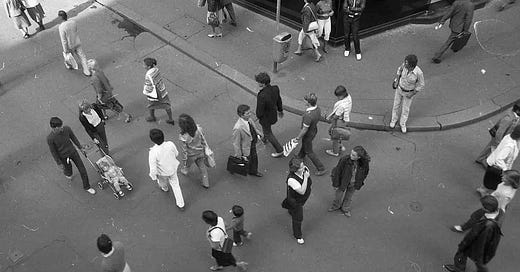As I skimmed the newsletters piled up in my inbox and glanced at my latest writing ideas, I suddenly realized that most of the Substack texts I read and post can be written at a desk without ever leaving the house.
But if you read classics of the modern feuilleton by the likes of Joseph Roth, Siegfried Kracauer, or Walter Benjamin, they thrive on flânerie, being on the road and mingling with people.
Interestingly, it's precisely AI-friendly authors like Tyler Cowen and Jasmine Sun who have recently pointed out how valuable encountering the non-digital reality has become:
„AI raises the value of travel to other places, to very different places (...) to see parts of the past worlds (...) before they disappear.“ —Tyler Cowen
„I want to do work grounded in place and culture, to put human faces on abstract secular trends.“—Jasmine Sun
Old Europe
I noticed the indoor bias of digital writing during a recent trip to Switzerland. Spared from the ravages of war and, pleasingly often, from mindless "modernization," Switzerland boasts an exceptional patina compared to most globalized places. Sure, from an overseas perspective, Switzerland or even Europe may seem like a museum resting on invisibly channeled financial flows and fiber optic cables, a nostalgic backdrop for tourists in an escapist mood.
The value of the cultural perspective is obvious: it protects against falling for false romanticization. But, for all its semiotics, it overlooks the rough, brittle harshness of the real, establishing a different, spatial relationship to time. What if we were to forget the apparent cultural-theoretical readings ("invented tradition," "retro“, „fake“) for a moment and sensually engage with a much more elementary materiality?
On my trip to Switzerland, I realized that monuments and landmarks interest me so little because they need a narrative, because they are assertions. Everyday trivialities – park benches, display cases, door handles – however, are actual traces of lived life, of life possibilities that literally existed, which I can touch just as someone before me has touched them. They form not only a temporal continuum but a material one: whose body might have pressed its weight on this object before me and left an infinitesimal abrasion?
A physical continuum
In my hotel, there were heavy, adjustable radiators and windows that could be opened and closed by hand – no constantly humming air conditioning; there were newspapers that smelled of printer's ink – an alternative to the ubiquitous flat screen. Again, you can interpret such details as stagings for those craving nostalgia. But you can also experience them as remnants from another time, as something that is still there, like the never-removed "no parking" sign from 1956 that I spotted in a courtyard entrance, like the surprisingly acceptable train station restaurant that still upholds the time when a train journey was something glamorous, like the antiquarian bookshop that continues to exist, even if it is rarely open.
Mossy stones remind us that nature will outlast the built environment. Public drinking water fountains bring a communal idea of urbanity to life. Small family businesses that have stood the test of time bear witness to a capitalism of diligence and ingenuity before the cheap chains came along.
It's all there, still there, and can be touched anytime—a multitude of inspiringly human worlds hidden in plain sight.
Just get up from your desk and go outside.





I don't see it so much as an "indoor bias" but a wholesale preference for WORDS. Culture has been reduced to words, and your article reminds us that there's more to it - door handles, park benches and other "stuff". Benjamin got this too. He was "interpreting" mainly the stuff around us instead of the words whith which we all too often deceive each other.
Very true. Yet the "indoor bias" is not limited to digital writing. It is zeitgeist. I have been a keen and avid runner for decades. In the past, parks around the world were full of runners. And very few people went to fitness studios or gyms. Today, I face the exact opposite. I hardly meet other runners outside, but come across crowded gyms around the world. Nothing beats the outdoors. The wind, the sound of birds, the four seasons are invaluable for me. Clearly, I am a dying species.